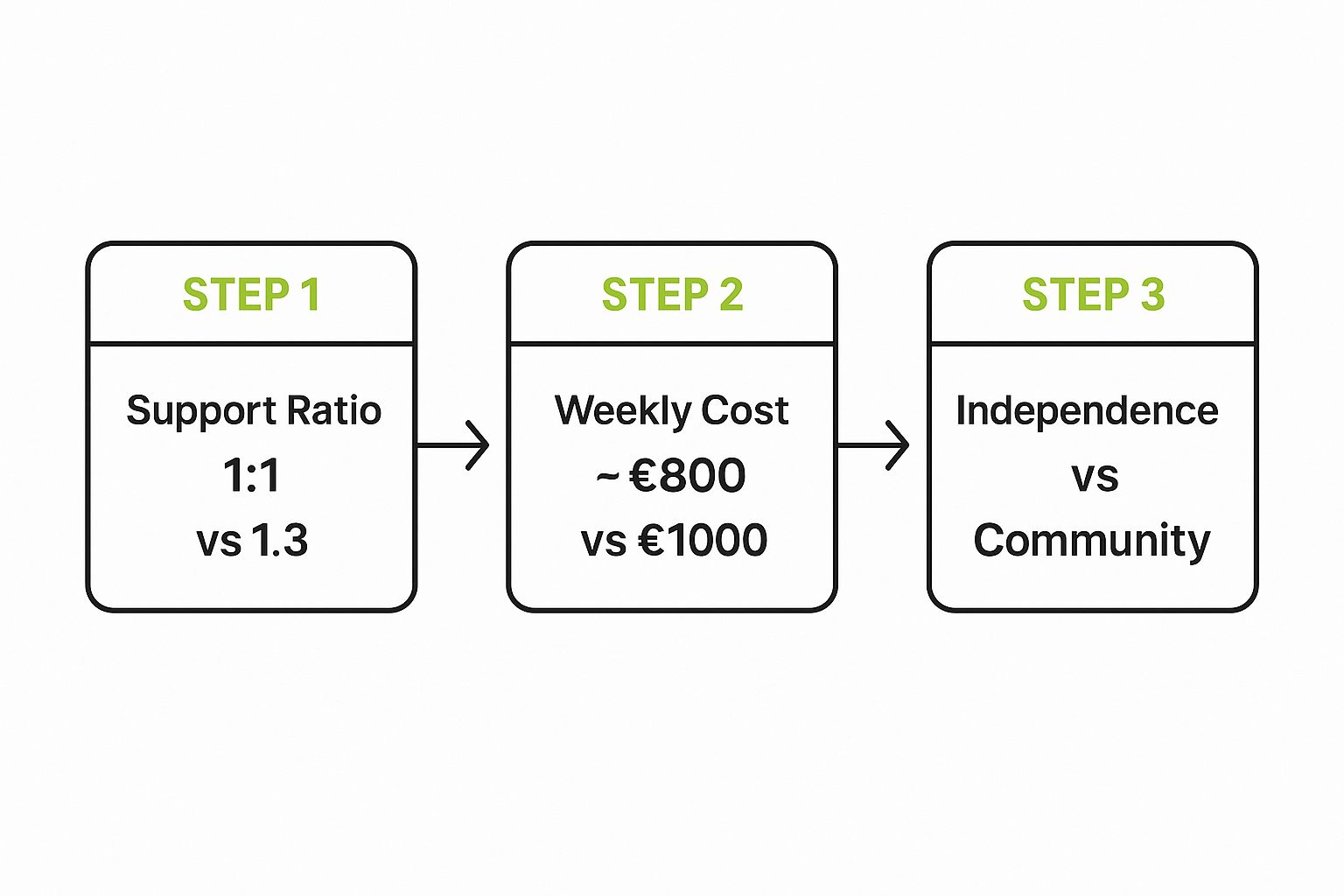Picture this: a dedicated professional carer, living in the home, providing constant and truly personal support. That's the heart of 24-hour live-in care. It’s a world away from a care home, offering genuine one-to-one assistance that allows your loved one to stay in the familiar comfort of their own surroundings.
What Is 24-Hour Live-In Care Really Like?

Many people assume 24-hour live-in care just means having someone in the house all the time. While that’s part of it, the reality is much more dynamic and compassionate. It’s less of a service and more of a partnership, one built to protect dignity and champion independence at home.
So, how does it work? A professional carer moves into a spare room in your loved one's house, becoming a continuous, reassuring presence. They're there to help whenever it's needed, day or night. But their role goes far beyond ticking off a list of tasks; it’s about creating a safe, nurturing environment where someone can genuinely thrive.
This one-to-one focus is the real game-changer. Forget the rigid timetables of a residential home. A live-in carer adapts to your loved one’s unique routines and preferences. From their morning cuppa just the way they like it to their favourite afternoon TV shows, the care revolves around the individual, not the other way around.
Who Benefits Most From This Approach?
While many people could benefit from this level of support, 24-hour live-in care is a real lifeline for specific situations. It's a fantastic option for those who need consistent supervision but dread the thought of leaving their home behind.
This kind of support often makes all the difference for:
- People with advanced dementia or Alzheimer’s: For someone who might wander or need frequent reassurance, especially overnight, a constant presence is invaluable.
- Those with complex health needs: When regular medication, mobility help, or close monitoring is required, a live-in carer provides that expert support.
- Individuals recovering from surgery or a serious illness: It offers a temporary but intensive level of help to get back on their feet safely at home.
- Older adults feeling isolated or vulnerable: Having someone there provides not just security but also vital companionship.
At its core, 24-hour live-in care is a commitment to preserving quality of life. It’s about making it possible for someone to keep enjoying their own home, garden, pets, and community, all with the peace of mind that help is always within reach.
Ultimately, this model brings enormous reassurance to families. To get a better sense of where this fits into the wider world of care, this comprehensive guide to in-home care for seniors is a great resource. It’s a solution that brilliantly balances safety with the powerful emotional benefit of staying home. For a closer look at different options, you can also read our ultimate guide to care at home services to learn what makes them so great.
The Real Comforts of Home: Why Staying Put Matters

When we think about arranging care, it's easy to get bogged down in the practicalities – the schedules, the tasks, the logistics. But choosing 24-hour live-in care is about something much deeper than that. It’s a decision to protect the one place where a person feels most like themselves: their own home.
There’s a psychological comfort in familiar surroundings that no other setting can truly match. A home isn't just four walls; it’s a lifetime of memories held in the photos on the mantelpiece, the worn armchair in the corner, and the view from the kitchen window. This sense of continuity provides a vital anchor, especially for someone living with a condition like dementia.
More Than Just Care: Companionship and Connection
One of the most powerful aspects of live-in care is the genuine relationship that blossoms between a person and their carer. This isn't about a constant rotation of new faces, which you often find in residential homes. Instead, it’s about one dedicated person building a real sense of trust and understanding.
This consistent presence is a powerful antidote to the loneliness that affects so many older people. A live-in carer isn't just there to help; they become a trusted friend—someone to share a cup of tea with, chat about the day, or simply enjoy a quiet moment together.
This one-to-one companionship helps to:
- Ease feelings of isolation: Having a friendly, familiar face around for a conversation makes all the difference.
- Keep the mind engaged: Sharing stories, playing a card game, or going for a gentle walk provides welcome mental stimulation.
- Offer emotional security: Knowing someone is right there for you during moments of worry or confusion is incredibly reassuring.
The true value of live-in care isn't just in managing physical needs, but in nurturing a person's spirit. It’s about making sure they feel seen, heard, and valued every single day, right where they belong.
Personalised Support for Better Health
The advantages go well beyond emotional wellbeing and have a direct, positive impact on health. For starters, staying at home dramatically lowers the risk of exposure to infections that can circulate in communal settings.
More importantly, a live-in carer provides truly personalised care that flexes and adapts to a person's needs as they change. This simply isn't possible when staff are trying to look after multiple residents at once.
This bespoke support improves health outcomes in very real ways:
- Proper Nutrition: Meals can be cooked exactly to someone's taste and dietary needs, encouraging them to eat well and stay hydrated.
- Reliable Medication Management: A carer ensures that complex medication schedules are followed to the letter, removing any worry about missed doses.
- Prompt Attention: Any small change in health or mood is noticed right away, so minor issues can be addressed before they escalate.
This dedicated, one-to-one focus is fundamental to how personalised home care supports independent living, empowering individuals to stay in control of their own lives.
Ultimately, the ability to wake up in your own bed, eat when you want to, and be surrounded by a lifetime of treasures is priceless. It’s about dignity, independence, and a quality of life that feels rich and meaningful. This is what makes 24-hour live-in care such a powerful and positive choice.
Figuring Out Live-in Care Costs and Funding
Let's talk about the money side of things. It’s often the biggest hurdle and the part that causes the most worry when you're thinking about 24-hour live-in care. Looking at the numbers can feel a bit daunting at first, but once you understand what's included and what help you might be able to get, it all becomes much more manageable.
The reality is that full-time care comes at a cost. In the UK, you can expect the average daily rate for a live-in carer to be around £206. That adds up, potentially totalling over £75,000 for a full year. While some home care support might be covered by your local council, most families arrange and pay for live-in care privately. You can get a clearer picture by exploring the breakdown of these care at home costs and seeing how they stack up against other options.
What Do the Fees Actually Cover?
When a care provider gives you a weekly or daily rate, it’s not just the carer's wages. It’s an all-in figure designed to cover the entire managed service, so you know exactly where you stand.
A typical live-in care package will almost always include:
- The Carer’s Salary: This is the lion's share, paying for their professional skill and round-the-clock presence.
- Agency Fees: Think of this as the behind-the-scenes work. It covers meticulous recruitment, DBS checks, specialist training, and the ongoing management that ensures everything runs smoothly.
- Travel Expenses: This often covers the cost of the carer getting to and from your loved one's home for their shifts.
- Support and Management: You're not just hiring an individual; you're buying into a support system. This includes a dedicated care manager and a 24/7 on-call line for any emergencies.
One extra thing to budget for is the carer's living costs. While they get a salary, you’ll need to cover their food and a share of the household bills while they’re staying with you.
To help you see the bigger picture, here’s a quick comparison of what you might expect to pay for different types of elderly care across the UK.
Comparing Care Options Typical Weekly Costs
This table provides a comparative overview of the average weekly costs for different types of elderly care in the UK, helping families to budget and plan effectively.
| Care Option | Average Weekly Cost (GBP) | Key Features |
|---|---|---|
| Live-in Care | £1,500 – £2,000+ | One-to-one, personalised care in the comfort of your own home, 24/7 support. |
| Care Home (Residential) | £850 – £1,200 | Communal living with social activities, care available from staff on-site. |
| Care Home (Nursing) | £1,000 – £1,600 | Includes the benefits of a residential home with the addition of 24-hour nursing staff. |
| Hourly Home Care | Varies widely (£1,000+) | Flexible visits for specific tasks (e.g., meals, personal care), but costs escalate quickly for round-the-clock cover. |
As you can see, while the headline figure for live-in care seems high, it becomes much more competitive when compared to the cost of a nursing home, especially when providing one-to-one, dedicated support.
Looking into UK Funding Options
While many families do pay for care themselves, it's always worth checking if you can get financial help. There are official channels that can provide assistance, and although it can take a bit of persistence to secure, the support can make a huge difference.
The two main sources for state funding come from your Local Authority and the NHS. Getting your head around how these systems work is the first step to unlocking the support your family might be entitled to.
Navigating the funding landscape requires a proactive approach. Understanding the assessment processes for both Local Authority and NHS support is essential to unlocking potential financial aid for 24-hour live-in care.
Local Authority Funding
Your local council is legally required to assess anyone who seems to need care and support. It all starts with a needs assessment, which is simply a conversation to understand what help your loved one requires to live safely and happily. They'll look at everything from help with washing and dressing to their emotional and social wellbeing.
If this assessment shows they have eligible needs, the next step is a financial assessment (often called a means test). This is where the council looks at your loved one’s income and savings to work out how much they should contribute to their care costs.
- Savings Threshold: In England, if someone has more than £23,250 in capital, they’ll generally be expected to pay for their own care.
- Direct Payments: If you are eligible for funding, you can ask for it to be paid directly to you. These 'Direct Payments' give you the freedom to choose your own care provider, including a 24-hour live-in care service that suits you best.
NHS Continuing Healthcare (CHC)
This is a different pot of money altogether. For people with very complex and serious health needs, NHS Continuing Healthcare (CHC) may be available. It's a package of care that is fully funded by the NHS—completely free of charge—for people whose main need is a health one.
Getting CHC funding is known for being a tough process. It involves an in-depth assessment by a team of different health professionals who use a very specific framework. It's not about having a particular illness; it's about the intensity, complexity, and unpredictability of someone's overall health needs. If your loved one is found to be eligible, the NHS will pay for the entire cost of their 24-hour live-in care.
Live-In Care vs Residential Care Homes
Deciding on the right care for a loved one is one of the toughest, most important choices a family will ever make. It usually boils down to two very different paths: the dedicated support of 24-hour live-in care at home, or the structured environment of a residential care facility. While both are designed to provide support and keep someone safe, the day-to-day experience they offer couldn't be more different.
At its core, the decision is between one-to-one, personal attention and a more community-focused model. Live-in care means a professional carer is there just for your loved one, adapting entirely to their routines, preferences, and needs, day and night. On the other hand, residential care homes work with a staff-to-resident ratio, so carers naturally have to split their time and attention among many different people.
Personalised Attention vs A Communal Setting
The most significant difference really is that level of personal attention. Think about a carer who knows exactly how your mum likes her morning cup of tea, or who can spend a whole afternoon helping your dad with his beloved garden. That’s what live-in care is all about—the support plan is built from the ground up, completely around one person.
In a care home, the staff are dedicated and professional, of course, but their responsibilities are spread across all the residents. This means there are usually set times for meals, activities, and personal care. While that structure is perfect for some, it can feel quite limiting for others who really value their personal routines and independence.
This is the central point in the discussion around how care at home can positively replace care homes, as it allows people to continue living life on their own terms. For many, that ability to stay in control of their own day is absolutely priceless.
The Financial Perspective for Individuals and Couples
Cost is, without a doubt, a major factor. At first glance, live-in care might seem like the more expensive option, but when you look closer—especially for couples—the picture changes. A residential home charges per person, which means the cost doubles if both partners need looking after.
With 24-hour live-in care, a single carer can often support a couple within their own home for a fee that is considerably less than paying for two separate beds in a care home. This often makes it a much more sensible and affordable solution for partners who want to stay together.
The core decision hinges on what you value most: the bespoke, one-to-one support that preserves independence at home, or the social structure and shared resources of a communal environment.
This infographic helps to clearly lay out the key differences.

As you can see, while the weekly costs might look similar in some cases, the level of direct, personal support and the independence you get with live-in care are in a different league entirely.
Independence, Community and National Trends
The demand for 24-hour live-in care is on the rise across the UK. This is largely driven by our ageing population and a very clear, widespread preference for staying put at home. Recent figures show that of the 673,000 people in England receiving local authority-funded care, a massive 72.5% are being supported in their own homes.
This isn't just a small shift; it points to a national trend towards home-based care. Projections even suggest the number of people who will need 24-hour care is set to double by 2037.
While the social life of a care home can be a real plus for some, offering ready-made companionship, it doesn't suit everyone. For many, the comfort of their own community—familiar neighbours, local shops, and their own garden—is far more valuable than a new social scene. When weighing up your options, it's also worth thinking about the wider healthcare landscape and the differences between private healthcare vs NHS services.
Ultimately, the right choice always comes down to the individual’s personality, their specific health needs, and what truly makes them feel happy, safe, and genuinely at home.
How to Arrange 24-Hour Live-in Care
Organising 24-hour live-in care can feel a bit daunting at first, but if you break it down into simple, manageable steps, the whole process becomes much clearer. Let's walk through everything you need to do, from figuring out the right level of support to welcoming a carer into the home.
The journey doesn't start with frantic calls to care agencies. It actually begins with a quiet, honest look at what your loved one truly needs. Getting this right from the very beginning is the key to finding support that fits their life, personality, and daily routine like a glove.
Starting with a Care Needs Assessment
Before you can find the right help, you have to get a complete picture of what that help looks like. A proper care needs assessment is the foundation for any successful live-in care arrangement. And this isn't just a medical checklist; it’s about understanding the whole person.
Think about these different areas to build a detailed profile:
- Personal Care: How much help is needed with daily tasks like washing, dressing, or using the loo? Is support needed during the night?
- Mobility: Can they get around the house safely by themselves? Do they need a hand getting out of a chair, tackling the stairs, or popping outside for some fresh air?
- Medical Needs: Is there a complex medication schedule to keep on top of? Are there specific conditions, like dementia or recovery after an operation, that need a carer with specialist knowledge?
- Household Tasks: What jobs around the house have become difficult? Think cooking, cleaning, laundry, and shopping.
- Companionship and Social Life: What are their hobbies? Do they feel lonely or cut off from the world? What would really lift their spirits and improve their emotional wellbeing?
Once you've got a clear handle on these needs, you'll be in a much stronger position to find a provider who can offer the right kind of support. This initial homework is absolutely invaluable.
Finding and Vetting Reputable Agencies
With your assessment done, it's time to start looking for a care provider. It's so important to choose a reputable agency that is properly regulated and has a solid track record. In England, for example, any provider of 24-hour live-in care must be registered with the Care Quality Commission (CQC).
The CQC inspects and rates services as Outstanding, Good, Requires Improvement, or Inadequate. You should always check a provider's latest CQC report on their website – it gives you an unbiased look at how safe and effective they are. A 'Good' or 'Outstanding' rating is a really strong sign that you're dealing with a high-quality service.
When you start talking to agencies, don't be shy about asking lots of questions. A good provider will be happy to answer them and will be completely transparent.
A sure sign of a quality provider is how much they focus on matching the carer to the client. They should be just as interested in your loved one's personality and lifestyle as they are in their medical requirements.
Co-creating the Perfect Care Plan
Once you've chosen an agency, the next stage is to work together on a detailed care plan. Think of this document as the blueprint for your loved one's care. It’s something that should be created with input from you, your loved one, and the agency to make sure everyone is on the same page from the start.
A good care plan is much more than a simple to-do list. It should cover everything from the daily routine and meal preferences to what to do in an emergency and what activities your loved one really enjoys. It's a living document, too, designed to be reviewed and tweaked as needs change over time.
This collaborative way of working ensures the care is truly person-centred. It confirms that the support will respect your loved one's dignity, encourage their independence, and genuinely make their life better.
Matching the Carer and Preparing the Home
The final piece of the puzzle is finding the right carer. The agency will use all the information from your assessment and the care plan to find a professional whose skills and personality are a great fit. A good match is about more than just qualifications; it's about finding someone your loved one will genuinely get along with.
After a carer has been chosen, the last thing to do is get the house ready. This really just means making sure the carer has a private, comfortable room of their own to sleep and rest in. A warm welcome helps build a positive relationship right from the beginning and sets the stage for a smooth and successful 24-hour live-in care experience.
What Does a Professional Live-in Carer Actually Do?

It’s easy to think of a live-in carer as just a friendly companion, but their role is so much more than that. A professional brings a huge amount of training and real-world experience to the table, delivering a careful blend of practical help, personal care, and emotional support. This is what makes a 24-hour live-in care arrangement truly work.
Every carer's responsibilities are shaped around the individual they're supporting, all laid out in a bespoke care plan. The relationship is built on trust, professionalism, and a genuine desire to help someone live a better, more comfortable life in their own home.
More Than Just a Helping Hand: Daily Support
A live-in carer's day is guided entirely by the needs and rhythms of the person they look after. Their duties go far beyond just the basics, creating a complete support system that covers health, safety, and overall well-being.
So, what does that look like day-to-day?
- Personal Care: Assisting with washing, dressing, and hygiene in a way that’s always dignified and respects personal space.
- Medication Management: Making sure the right medication is taken at the right time, every time, sticking precisely to the prescribed schedule.
- Mobility Support: Helping with moving around the house – from getting out of bed to enjoying a gentle walk – which dramatically reduces the risk of falls.
- Meal Preparation: Cooking nutritious meals that are not only delicious but also cater to specific dietary needs and personal preferences.
- Light Housekeeping: Keeping the home clean, tidy, and safe. This includes things like laundry, vacuuming, and doing the washing up.
This role is becoming more and more critical. Although official numbers are hard to pin down, it's estimated there are around 25,000 live-in carers in the UK. With an ageing population, that figure is only set to grow. You can find more data on the workforce and future demand from New Europeans UK.
How the Working Week is Structured
Alongside all the practical tasks, one of the most important parts of the job is simply being there. A great carer offers a friendly, reassuring presence, ready for a chat, to share a hobby, or to help someone stay connected with friends and their community.
A professional live-in carer is much more than a helper; they are a trained support specialist, a companion, and a crucial link to maintaining independence and safety at home.
It’s a common misconception that carers work 24 hours a day. They don’t. To ensure they stay fresh and avoid burnout, their week is properly structured. A typical day includes a set number of working hours and agreed-upon breaks, usually two to three hours, where they can rest and have some downtime.
Carers also have full days off each week. During these breaks, the care agency arranges for a relief carer to step in seamlessly. This organised approach means your loved one receives uninterrupted, high-quality 24-hour live-in care, while also protecting the carer’s well-being. It’s this balance that creates a sustainable and positive partnership for everyone.
Common Questions About Live-In Care
Deciding on 24-hour live-in care is a big step, and it's completely normal to have a lot of practical questions. Getting clear answers is the best way to feel confident you're making the right choice for your family.
Let's walk through some of the things people often ask. We want to clear up any uncertainties you might have as you explore what's involved, from how a carer gets their breaks to the official standards that keep your loved one safe.
How Does a Live-In Carer Get Breaks and Time Off?
This is a really important question. A live-in carer isn't expected to be on duty 24/7. They typically have an agreed-upon working schedule, which includes breaks of around 2-3 hours each day. Just like any other job, they also need regular days off each week to rest and recharge.
So, what happens during this downtime? Well, that's all worked out beforehand. Sometimes, family members might be happy to step in for a few hours. Alternatively, the care provider can arrange for a relief carer to cover these periods, ensuring support is always there. It's all detailed in the care plan from the very start, so everyone knows what to expect.
What Happens if My Loved One and the Carer Don’t Get Along?
Finding the right personality fit is just as important as finding the right skills. A good care provider puts a lot of effort into matching clients and carers based on personality, interests, and lifestyle. But sometimes, despite best efforts, it just doesn't click.
If you find yourselves in this situation, the first thing to do is contact the care agency straight away. They’ve seen it all before and are skilled at navigating these delicate issues.
A strong, positive relationship between your loved one and their carer is the absolute cornerstone of successful live-in care. Never feel hesitant about raising concerns with your provider—their main priority is ensuring your loved one feels safe, comfortable, and happy.
If things can't be smoothed over, the agency will work to find a new carer who is a much better match.
Is 24-Hour Live-In Care Regulated in the UK?
Absolutely. When you go through a professional care agency, 24-hour live-in care is a fully regulated service. This is crucial for ensuring safety and quality standards are met.
The specific regulatory body depends on where you are in the UK:
- In England, it’s the Care Quality Commission (CQC).
- In Scotland, you're looking for the Care Inspectorate.
- In Wales, it's the Care Inspectorate Wales.
- In Northern Ireland, providers are regulated by the Regulation and Quality Improvement Authority (RQIA).
Before committing to any provider, you should always verify that they are registered with the correct regulatory authority for your region.
At Cream Home Care, we believe in providing clear answers and compassionate guidance to help you find your way. If you'd like to talk through your own needs for 24-hour live-in care, please get in touch with us at https://creamhomecare.co.uk.






